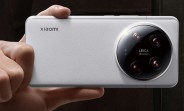
The Xiaomi 14 Ultra is here. The Chinese launch happened just before the Mobile World Congress started but the global announcement takes place today. The 14 Ultra made refinements to the design and the cameras – the main camera has a second generation 1-inch sensor and a brighter f/1.63 to f/4 stepless aperture. The periscope zoom lens also got a bump from an f/3.0 to an f/2.5, while the rest of the imagers remained the same. Xiaomi added the latest Snapdragon 8 Gen 3, up to 16GB of RAM, a bigger 5,300mAh battery, and two-way satellite communication on the special Titanium Edition of the phone.
We finally put a real face to the Nothing Phone (2a) rumors, thanks to proper press renders. They reveal a design with two rear cameras that sits horizontally, instead of vertically, and Glyph LEDs. The Nothing Phone (2a) is coming on March 5 with a custom Dimensity 7200 Pro chipset.
Asus confirmed that the Zenfone 11 Ultra will arrive on the global market on March 14. The company didn’t share any specs but we already had a mega-leak that revealed a lot – expect a 6.78-inch LTPO AMOLED display with FHD+ resolution and a 1-144Hz refresh rate, Qualcomm’s Snapdragon 8 Gen 3 chipset alongside 16 GB LPDDR5X RAM and 512 GB UFS 4.0 storage, and the same trio of cameras found on the ROG Phone 8 Pro – 50MP main cam with an IMX890 sensor, 32MP telephoto shooter with 3x optical zoom and a 13MP ultrawide camera.
The sub-sites for several European countries already list the upcoming mid-rangers, even though Samsung hasn’t set an official reveal date.
Closing with some iPhone news – Apple confirmed that the iPhone 15 series phones have batteries that should hold up for longer. Apple’s specific wording is that the batteries can retain 80% of their original capacity after 1,000 complete charge cycles, instead of 500, which was below the industry norm of 800.
Finally, the iPhone 16 Pro and Pro Max will arrive in a new Cement Grey, which is reportedly a shade of space gray similar to the iPhone 6, and in Desert Yellow – similar to the golden iPhone 14 Pro.
Apple used a specific charging test which involved charging and discharging the battery 1,000 times under specific conditions that would simulate real-world use cases.
















